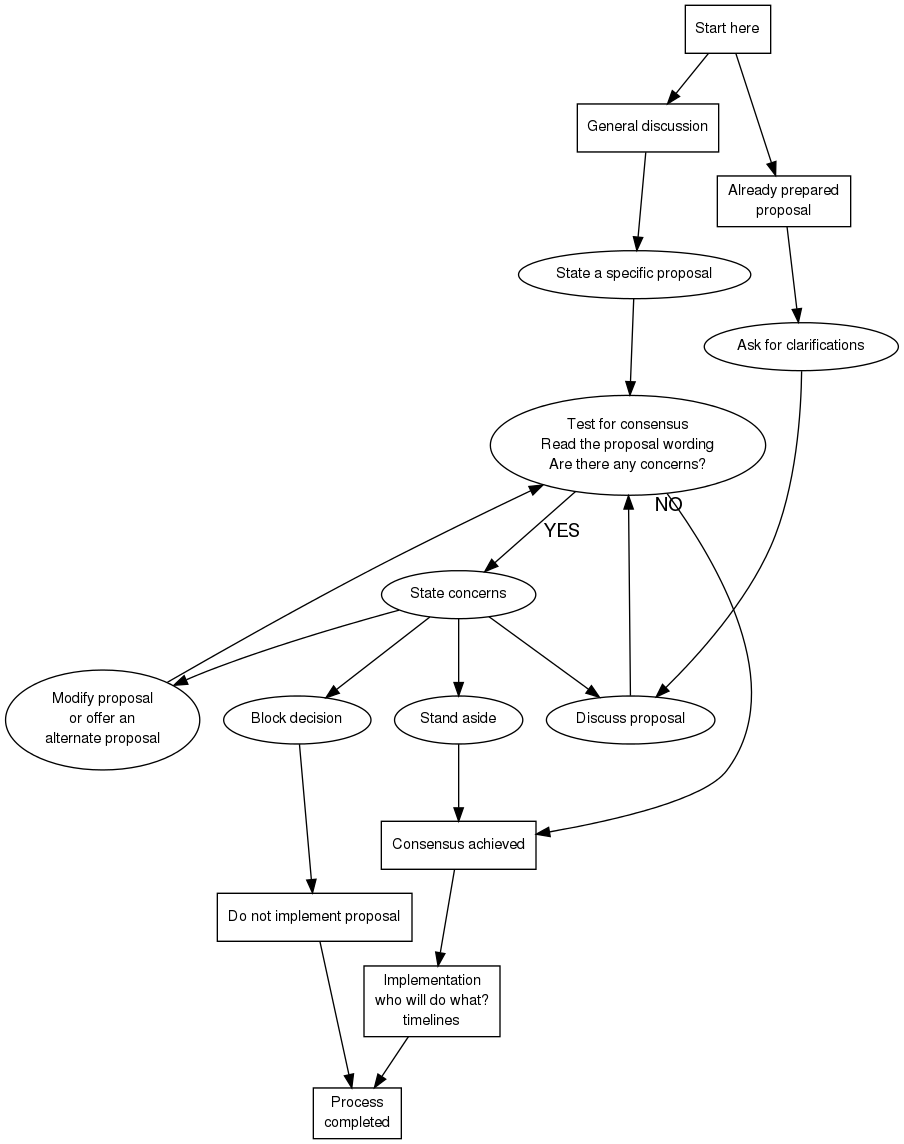Difference between revisions of "Consensus process"
| (6 intermediate revisions by the same user not shown) | |||
| Line 1: | Line 1: | ||
| + | This graph shows how consensus works in a meeting. | ||
| + | |||
| + | Before the meeting, it is suggested that community members prepare by discussing the issue less formally. When possible they should bring well thought out proposals to the meeting. Also when possible, the wording of these proposals should be publicized to the community in advance. | ||
| + | |||
| + | However, there are times when all that is brought is a topic to be discussed. In these situations, for time critical items, a proposal may need to be developed at the meeting. | ||
| + | |||
<graphviz> | <graphviz> | ||
| − | digraph | + | digraph Consensus { |
| + | |||
| + | node [fontname="Helvetica", fontsize="11"] | ||
| + | edge [fontname="Helvetica"] | ||
start [label="Start here", shape="rectangle"] | start [label="Start here", shape="rectangle"] | ||
discussion1 [label="General discussion", shape="rectangle"] | discussion1 [label="General discussion", shape="rectangle"] | ||
| − | proposal1 [label=" | + | proposal1 [label="State a specific proposal"] |
| − | proposal2 [label=" | + | proposal2 [label="Already prepared\nproposal", shape="rectangle"] |
discussion2 [label="Discuss proposal"] | discussion2 [label="Discuss proposal"] | ||
| − | test [label="Test | + | test [label="Test for consensus\nRead the proposal wording\nAre there any concerns?"] |
modifications [label="Modify proposal\nor offer an\nalternate proposal"] | modifications [label="Modify proposal\nor offer an\nalternate proposal"] | ||
concerns [label="State concerns"] | concerns [label="State concerns"] | ||
| − | block [label="Block decision | + | block [label="Block decision"] |
standaside [label="Stand aside"] | standaside [label="Stand aside"] | ||
consensus [label="Consensus achieved", shape="rectangle"] | consensus [label="Consensus achieved", shape="rectangle"] | ||
action [label="Implementation\nwho will do what?\ntimelines", shape="rectangle"] | action [label="Implementation\nwho will do what?\ntimelines", shape="rectangle"] | ||
| − | + | clarify [label="Ask for clarifications"] | |
| − | + | no_implementation [label="Do not implement proposal", shape="rectangle"] | |
| + | process_completed [label="Process\ncompleted", shape="rectangle"] | ||
start -> discussion1 | start -> discussion1 | ||
| Line 21: | Line 31: | ||
discussion1 -> proposal1 | discussion1 -> proposal1 | ||
| − | proposal1 | + | proposal1 -> test |
| − | |||
| − | proposal2 -> | + | proposal2 -> clarify |
| − | + | clarify -> discussion2 | |
discussion2 -> test | discussion2 -> test | ||
| − | test -> concerns [label=" | + | test -> concerns [label="YES"] |
| − | test -> consensus [ | + | test -> consensus [taillabel="NO"] |
| + | |||
concerns -> discussion2 | concerns -> discussion2 | ||
concerns -> modifications | concerns -> modifications | ||
| − | modifications -> | + | modifications -> test |
concerns -> standaside | concerns -> standaside | ||
concerns -> block | concerns -> block | ||
| + | block -> no_implementation | ||
standaside -> consensus | standaside -> consensus | ||
consensus -> action | consensus -> action | ||
| + | |||
| + | no_implementation -> process_completed | ||
| + | action -> process_completed | ||
} | } | ||
</graphviz> | </graphviz> | ||
| + | |||
| + | If a proposal does not go forward due to a block, someone can go back to square one in an attempt to develop a new proposal for a future meeting. This is not possible for some time critical items. It is not usually wise to reintroduce a proposal that is identical to one that was blocked unless the opinions of the community members have changed substantially. | ||
| + | |||
[[Category: Meetings]] | [[Category: Meetings]] | ||
Latest revision as of 09:27, 23 May 2008
This graph shows how consensus works in a meeting.
Before the meeting, it is suggested that community members prepare by discussing the issue less formally. When possible they should bring well thought out proposals to the meeting. Also when possible, the wording of these proposals should be publicized to the community in advance.
However, there are times when all that is brought is a topic to be discussed. In these situations, for time critical items, a proposal may need to be developed at the meeting.

If a proposal does not go forward due to a block, someone can go back to square one in an attempt to develop a new proposal for a future meeting. This is not possible for some time critical items. It is not usually wise to reintroduce a proposal that is identical to one that was blocked unless the opinions of the community members have changed substantially.